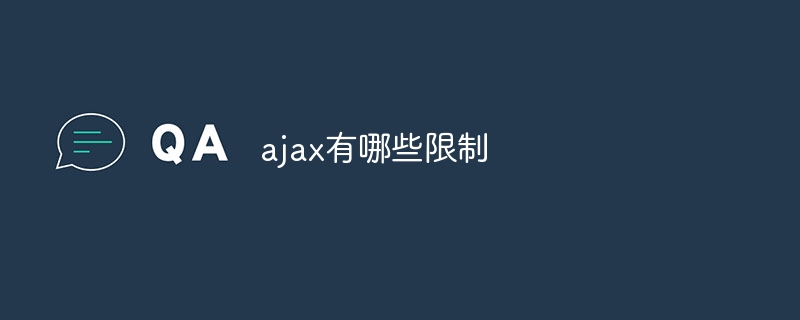Home >Web Front-end >Front-end Q&A >What are the limitations of ajax
What are the limitations of ajax
- DDDOriginal
- 2023-11-16 17:01:381464browse
The limitations of ajax are: 1. Same-origin policy, Ajax requests can only be sent to URLs with the same protocol, domain name, and port number as the current page; 2. Asynchronous communication, when processing Ajax requests, developers Need to handle callback functions or use asynchronous programming technologies such as Promise; 3. Indexability for search engines, search engine crawlers may not be able to detect content loaded through Ajax; 4. Browser compatibility, some older versions of browsers may not Supports certain Ajax functions; 5. Security, real-time communication with the server has security risks.

# Operating system for this tutorial: Windows 10 system, Dell G3 computer.
Ajax (Asynchronous JavaScript and XML) is a technology used to create interactive Web applications. It allows web pages to communicate with the server and dynamically update portions of the page content without refreshing the entire page. Although Ajax is very useful in web development, it also has some limitations.
Same-origin policy: Ajax is restricted by the same-origin policy. The Same Origin Policy is a security mechanism that restricts how content loaded by a web page from one source interacts with resources from another source. In other words, Ajax requests can only be sent to URLs with the same protocol, domain name, and port number as the current page. This means that if your web page needs to communicate with a server with a different domain name, you need to use technologies such as proxies or Cross-Origin Resource Sharing (CORS) to solve this problem.
Asynchronous Communication: Ajax is asynchronous, which means it can send requests in the background and continue other operations without blocking the user interface. However, this also means that when handling Ajax requests, developers need to deal with callback functions or use asynchronous programming techniques such as Promise. This can be a challenge for some developers, especially those who are used to synchronous programming.
Indexability to search engines: Since Ajax requests are sent in the background and do not refresh the entire page, search engine crawlers may not detect it. Content loaded via Ajax. This may cause search engines to be unable to correctly index the content of the web page, thus affecting the search engine optimization (SEO) of the web page. To solve this problem, developers can use techniques such as pre-rendering or server-side rendering to ensure that search engines can process the web page correctly.
Browser compatibility: Although Ajax is a commonly used web development technology, different browsers may have different levels of support for Ajax. Some older browsers may not support certain Ajax features, or support them in a different way. Therefore, when developing Ajax applications, developers need to consider the compatibility of different browsers and perform necessary compatibility testing and repairs.
Security: Since Ajax sends requests in the background and can communicate with the server in real time, it also brings some security risks. For example, if developers do not properly validate and sanitize user input, it can lead to security issues such as cross-site scripting attacks (XSS). Therefore, when using Ajax, developers need to pay attention to security and take appropriate security measures, such as input validation and output filtering.
Although Ajax is very useful in web development, it also has some limitations. Same-origin policy, asynchronous communication, search engine indexability, browser compatibility and security are all issues that developers need to consider and solve when using Ajax. By properly handling these limitations, developers can take full advantage of Ajax and create efficient, interactive Web applications.
The above is the detailed content of What are the limitations of ajax. For more information, please follow other related articles on the PHP Chinese website!

